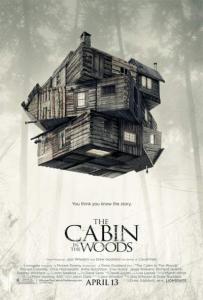 Even if you can’t name the exact movie, you know the story. Five young people head to the woods and wind up being terrorized by something that wants to kill, and possibly eat them, for various reasons. It doesn’t even have to be the woods, just as long as it focuses on a core group of death-friendly people being pursued by something awful. The number and personalities of the victims can vary, but typically in traditional horror movies they all end up gravitating to well-worn archetypes that are one-dimensional characters marching toward their inevitable deaths.
Even if you can’t name the exact movie, you know the story. Five young people head to the woods and wind up being terrorized by something that wants to kill, and possibly eat them, for various reasons. It doesn’t even have to be the woods, just as long as it focuses on a core group of death-friendly people being pursued by something awful. The number and personalities of the victims can vary, but typically in traditional horror movies they all end up gravitating to well-worn archetypes that are one-dimensional characters marching toward their inevitable deaths.
The characters (and even the stories) are formulaic to a fault, and that is what Cabin in the Woods exists for. Cabin Co-writer/producer Joss Whedon and Director/co-writer Drew Goddard have made their names over the years with shows like Buffy the Vampire Slayer, which continually took traditional and even clichéd moments, then made them fresh and original — or mocked them. Over both of their careers, Whedon and Goddard have continued this method of deconstructing the predictable and twisting it. Cabin in the Woods is no exception.
It’s tough to really explain what Cabin in the Woods is without spoiling what makes it worth watching. It is a horror movie, but it is more accurate to call it a horror movie within a comedy that is in another horror movie. There are layers to the film that contrast each other. One moment you are watching a gore-filled blood bath, the next you are listening to two guys crack jokes about their favorite monsters. It is similar to last year’s Tucker & Dale vs. Evil, which took a similar twist on an expected horror convention but focused more on the comedy angle.

I pity the people left in charge of marketing this movie. It is a difficult film to explain without ruining it. You have five kids–all of which match existing horror movie archetypes like the jock and the hot soon-to-be-naked blonde—heading to a remote cabin for a weekend of fun. Bad things happen.
But this is just one part of it, and not even the main driving force of the plot. As the kids are busy trying to avoid being horribly murdered, a mysterious group is watching them and manipulating events for their own purposes. And that’s all you’ll get from me.
The cabin horror narrative plays on the conventions of the genre to the point that it almost becomes like meta-fiction as they seem to recognize and comment on the situation they find themselves in, which leads to some very funny commentary. There is a price to pay for this approach though.

Sure, there is a reason for it that plays into the entire motif of the story, but none of the actors ever really have much to anchor them to the film or to make you feel invested in their fates. There are a few brief moments at the very start that attempt to quickly humanize and characterize the roles, and Fran Kranz as the paranoid stoner Mitch stands out a bit, but otherwise none of them really have much impact.
As a bit of a bonus though, the movie is also filled with several Buffy-verse familiars so fans of Whedon have extra incentive to check it out.
Cabin in the Woods is essentially one long “in-joke” between horror fans. It is the humor that will keep people talking, and it is the critical eye on the genre that will be remembered and have a lasting impact. After this, it will be tough to watch another traditional horror movie without thinking back to the conventions that Cabin called out.
 Conclusion
Conclusion
Cabin in the Woods is a clever and insightful parody of traditional horror films on one hand, and a genuinely decent horror movie in its own right on the other. The humor sometimes overshadows the horror, but in general it works on several levels. Fans of the medium will love the deconstruction of the familiar conventions, while non-fans can enjoy the unfolding mystery and wit of the film.
The only nagging issue is the lack of any real bond with the lead victims, who are generally overshadowed by the plot and the other characters in the film that are far more original. That is by design, but it is also a bit of a missed opportunity, especially late in the movie. That’s a minor concern though, and not one that seriously impacts the film.
After you see Cabin in the Woods, it will be hard to watch other horror movies that use traditional conventions without thinking back to this movie. So basically Joss Whedon and Drew Goddard may have just ruined the horror genre. Or maybe they helped to save it.



